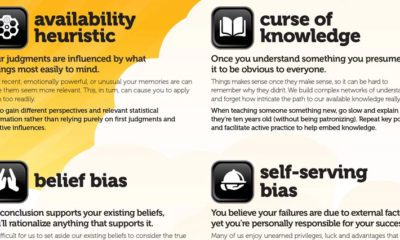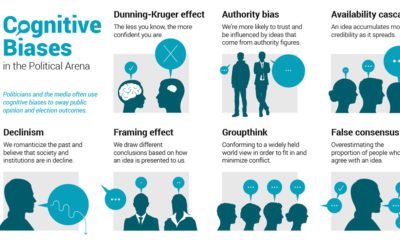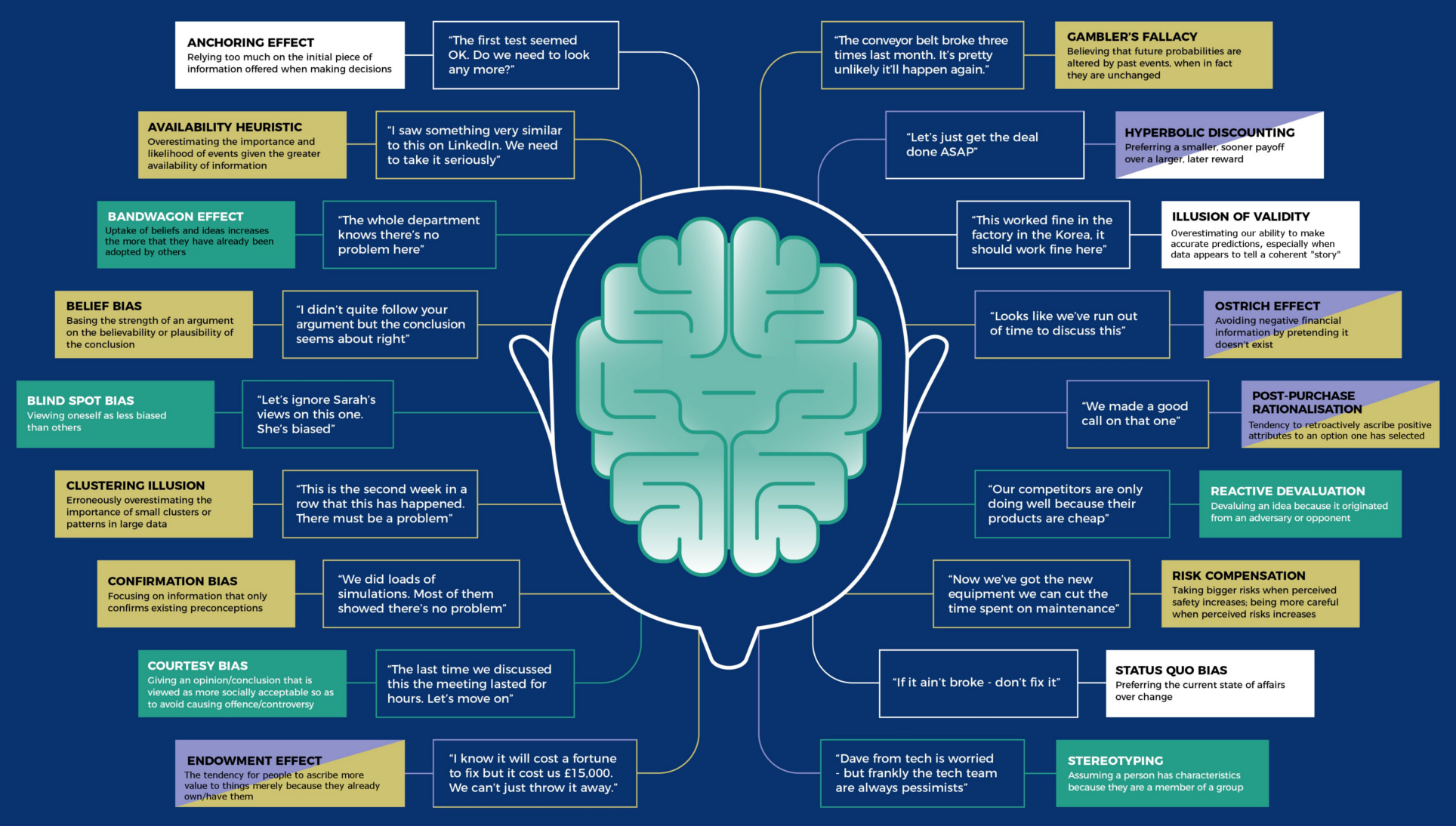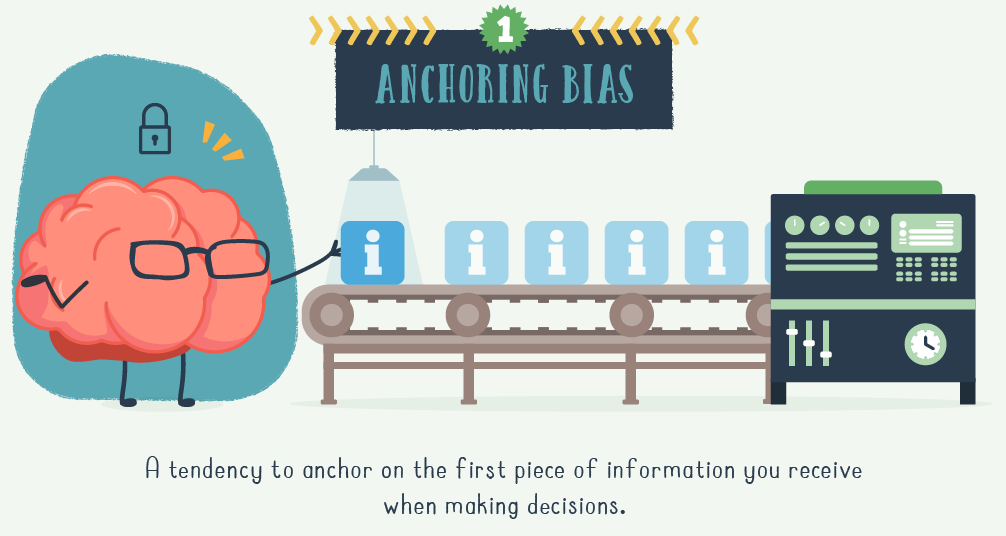Misc
50 Cognitive Biases in the Modern World

50 Cognitive Biases in the Modern World
Cognitive biases are widely accepted as something that makes us human.
Every day, systematic errors in our thought process impact the way we live and work. But in a world where everything we do is changing rapidly—from the way we store information to the way we watch TV—what really classifies as rational thinking?
It’s a question with no right or wrong answer, but to help us decide for ourselves, today’s infographic from TitleMax lists 50 cognitive biases that we may want to become privy to.
In the name of self-awareness, here’s a closer look at three recently discovered biases that we are most prone to exhibiting in the modern world.
Automation Bias
AI-infused applications are becoming incredibly good at “personalizing” our content, but will there come a time when we let algorithms make all of our decisions?
Automation bias refers to the tendency to favor the suggestions of automated systems.
Take Netflix, for example. Everything we see on the platform is the result of algorithms—even the preview images that are generated. Then, to harness the power of data and machine learning, Netflix categorizes its content into tens of thousands of micro-genres. Pairing these genre tags with a viewer’s history allows them to assign several of over 2,000 “taste profiles” to each user.
And while there’s nothing wrong with allowing Netflix to guide what we watch, there’s an enormous sea of content standing by. Estimates from 2015 claimed it would take nearly four years to watch all of Netflix’s content. Thousands more hours of content have since been added.
If we want to counter this cognitive bias, finding a new favorite series on platforms like Netflix may require some good old-fashioned human curiosity.
The Google Effect
Also known as “digital amnesia”, the aptly named Google Effect describes our tendency to forget information that can be easily accessed online.
First described in 2011 by Betsy Sparrow (Columbia University) and her colleagues, their paper described the results of several memory experiments involving technology.
In one experiment, participants typed trivia statements into a computer and were later asked to recall them. Half believed the statements were saved, and half believed the statements were erased. The results were significant: participants who assumed they could look up their statements did not make much effort to remember them.
Because search engines are continually available to us, we may often be in a state of not feeling we need to encode the information internally. When we need it, we will look it up.
– Sparrow B, et al. Science 333, 777 (2011)
Our modern brains appear to be re-prioritizing the information we hold onto. Notably, the study doesn’t suggest we’re becoming less intelligent—our ability to learn offline remains the same.
The IKEA Effect
Identified in 2011 by Michael Norton (Harvard Business School) and his colleagues, this cognitive bias refers to our tendency to attach a higher value to things we help create.
Combining the Ikea Effect with other related traits, such as our willingness to pay a premium for customization, is a strategy employed by companies seeking to increase the intrinsic value that we attach to their products.
For instance, American retailer Build-A-Bear Workshop is anchored around creating a highly interactive customer experience. With the help of staff, children (or adults) can assemble their stuffed animals from scratch, then add clothing and accessories at extra cost.
Nike also incorporates this bias into its offering. The footwear company offers a Nike By You line of customizable products, where customers pay a premium to design bespoke shoes with an extensive online configurator.
While there’s nothing necessarily wrong with our susceptibility to the Ikea Effect, understanding its significance may help us make more appropriate decisions as consumers.
What Can We Do?
As we navigate an increasingly complex world, it’s natural for us to unconsciously adopt new patterns of behavior.
Becoming aware of our cognitive biases, and their implications, can help us stay on the right course.
Politics
Charted: Trust in Government Institutions by G7 Countries
How much do you trust the government and its various institutions? We look at data for G7 countries for the time period of 2006-2023.
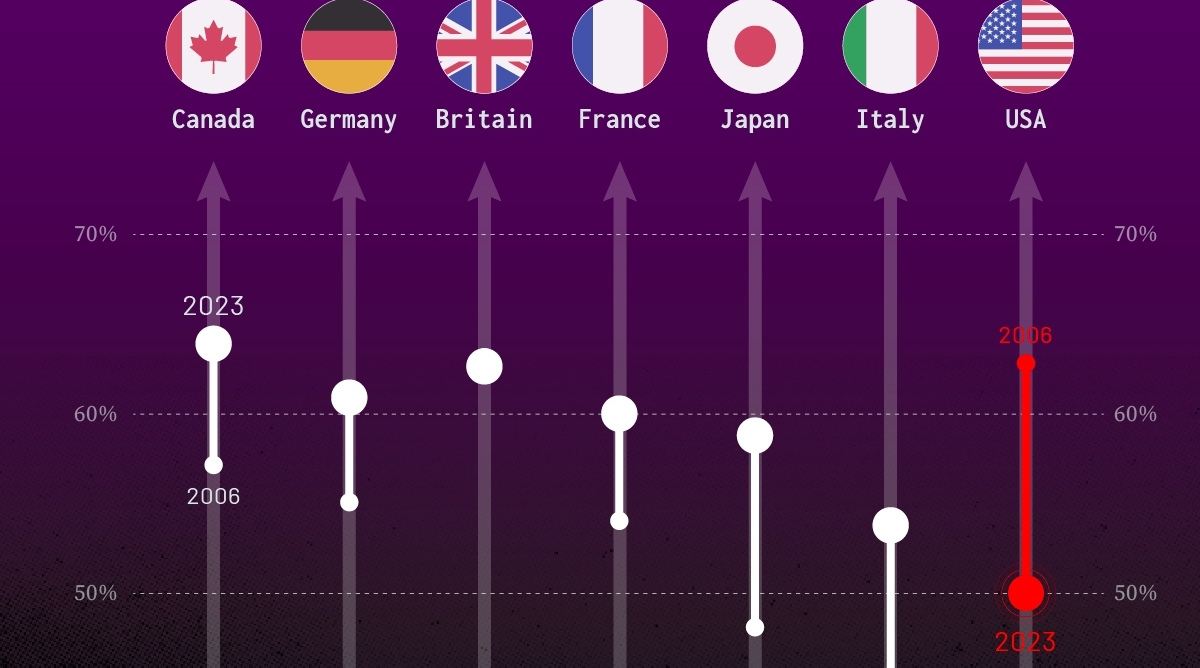
Trust in Government Institutions by G7 Countries
This was originally posted on our Voronoi app. Download the app for free on iOS or Android and discover incredible data-driven charts from a variety of trusted sources.
How much do you trust the government, and its various institutions?
It’s likely that your level of confidence probably depends on a wide range of factors, such as perceived competency, historical context, economic performance, accountability, social cohesion, and transparency.
And for these same reasons, trust levels in government institutions also change all the time, even in the world’s most developed countries: the G7.
Confidence in Government by G7 Countries (2006-2023)
This chart looks at the changes in trust in government institutions between the years 2006 and 2023, based on data from a multi-country Gallup poll.
Specifically, this dataset aggregates confidence in multiple national institutions, including the military, the judicial system, the national government, and the integrity of the electoral system.
| Country | Confidence (2006) | Confidence (2023) | Change (p.p.) |
|---|---|---|---|
| Canada | 57% | 64% | +7 |
| Britain | 63% | 63% | +0 |
| Germany | 55% | 61% | +6 |
| France | 54% | 60% | +6 |
| Japan | 48% | 59% | +11 |
| Italy | 41% | 54% | +13 |
| United States | 63% | 50% | -13 |
What’s interesting here is that in the G7, a group of the world’s most developed economies, there is only one country bucking the general trend: the United States.
Across most G7 countries, confidence in institutions has either improved or stayed the same between 2006 and 2023. The largest percentage point (p.p.) increases occur in Italy and Japan, which saw +13 p.p. and +11 p.p. increases in trust over the time period.
In the U.S., however, confidence in government institutions has fallen by 13 p.p. over the years. What happened?
Key Figures on U.S. Trust in Institutions
In 2006, the U.S. was tied with the UK as having the highest confidence in government institutions, at 63%.
But here’s where the scores stand in 2023, across various institutions:
| 🇺🇸 Institutions | Confidence (2023) |
|---|---|
| Military | 81% |
| Judiciary | 42% |
| National Government | 30% |
| Elections | 44% |
| Overall | 49% |
Based on this data, it’s clear that the U.S. lags behind in three key indicators: confidence in the national government, confidence in the justice system, and confidence in fair elections. It ranked in last place for each indicator in the G7.
One other data point that stands out: despite leading the world in military spending, the U.S. is only the third most confident in its military in the G7. It lags behind France (86%) and the United Kingdom (83%).
-

 Wealth6 days ago
Wealth6 days agoCharted: Which City Has the Most Billionaires in 2024?
-

 Mining2 weeks ago
Mining2 weeks agoGold vs. S&P 500: Which Has Grown More Over Five Years?
-

 Uranium2 weeks ago
Uranium2 weeks agoThe World’s Biggest Nuclear Energy Producers
-

 Education2 weeks ago
Education2 weeks agoHow Hard Is It to Get Into an Ivy League School?
-

 Debt2 weeks ago
Debt2 weeks agoHow Debt-to-GDP Ratios Have Changed Since 2000
-

 Sports2 weeks ago
Sports2 weeks agoThe Highest Earning Athletes in Seven Professional Sports
-

 Science2 weeks ago
Science2 weeks agoVisualizing the Average Lifespans of Mammals
-

 Brands1 week ago
Brands1 week agoHow Tech Logos Have Evolved Over Time

